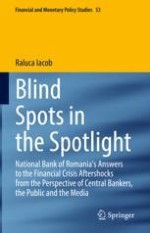2022 | OriginalPaper | Chapter
5. NBR Representatives About the Change of Public Communication After 2008
Author : Raluca Iacob
Published in: Blind Spots in the Spotlight
Publisher: Springer International Publishing
Activate our intelligent search to find suitable subject content or patents.
Select sections of text to find matching patents with Artificial Intelligence. powered by
Select sections of text to find additional relevant content using AI-assisted search. powered by
